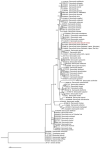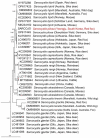First Report of Sarcocystis pilosa from a Red Fox (Vulpes vulpes) Released for the Re-Introduction Project in South Korea
- PMID: 38200820
- PMCID: PMC10778215
- DOI: 10.3390/ani14010089
First Report of Sarcocystis pilosa from a Red Fox (Vulpes vulpes) Released for the Re-Introduction Project in South Korea
Abstract
The red fox (Vulpes vulpes) is a known host for various parasites, including numerous helminths and protozoans. Among these, certain species in the genus Sarcocystis (phylum Apicomplexa) have been documented to possess the capability to infect red foxes as definitive hosts. In South Korea, red foxes have been introduced and released as part of a re-introduction program. However, two months after its release, one of the foxes was found dead because of illegal trapping. The fox was necropsied, and a subsequent coprological study revealed oocysts of Sarcocystis sp. in the intestinal contents. The oocysts were identified as Sarcocystis pilosa based on the 18S rRNA and cytochrome c oxidase subunit 1 (cox1) gene sequences. It exhibited a 99.7-100% identity with 18S rRNA gene sequences and 99.1-99.8% identity with cox1 gene sequences from other previously reported S. pilosa samples. Additionally, it showed identities of 95.4-96.4% and 91.1-91.5% with the cox1 gene sequences of S. hjorti and S. gjerdei, while demonstrating 99.6 and 98.1% identity with the 18S rRNA gene sequences of S. hjorti and S. gjerdei, respectively. This is the first report from mainland Asia, excluding the Japanese archipelago, indicating that the life cycle of S. pilosa persists in South Korea.
Keywords: 18S rRNA; cytochrome c oxidase subunit 1; host; red fox; restoration.
Conflict of interest statement
The authors declare no conflicts of interest.
Figures



Similar articles
-
The red fox (Vulpes vulpes) and the arctic fox (Vulpes lagopus) are definitive hosts of Sarcocystis alces and Sarcocystis hjorti from moose (Alces alces).Parasitology. 2010 Sep;137(10):1547-57. doi: 10.1017/S0031182010000399. Epub 2010 May 26. Parasitology. 2010. PMID: 20500918
-
First report of Sarcocystis pilosa sporocysts in feces from red fox, Vulpes vulpes schrencki, in Hokkaido, Japan.Int J Parasitol Parasites Wildl. 2019 Dec 5;11:29-31. doi: 10.1016/j.ijppaw.2019.12.001. eCollection 2020 Apr. Int J Parasitol Parasites Wildl. 2019. PMID: 31879592 Free PMC article.
-
Sarcocystis infection in red deer (Cervus elaphus) with eosinophilic myositis/fasciitis in Switzerland and involvement of red foxes (Vulpes vulpes) and hunting dogs in the transmission.Int J Parasitol Parasites Wildl. 2020 Oct 1;13:130-141. doi: 10.1016/j.ijppaw.2020.09.005. eCollection 2020 Dec. Int J Parasitol Parasites Wildl. 2020. PMID: 33083225 Free PMC article.
-
Molecular identification of Sarcocystis spp. in foxes (Vulpes vulpes) and raccoon dogs (Nyctereutes procyonoides) from Germany.Vet Parasitol. 2016 Apr 15;220:9-14. doi: 10.1016/j.vetpar.2016.02.011. Epub 2016 Feb 11. Vet Parasitol. 2016. PMID: 26995715
-
[Red fox (Vulpes vulpes) as reservoir of parasites and source of zoonosis].Wiad Parazytol. 2005;51(2):125-32. Wiad Parazytol. 2005. PMID: 16838621 Review. Polish.
Cited by
-
European Pine Marten (Martes martes) as Natural Definitive Host of Sarcocystis Species in Latvia: Microscopic and Molecular Analysis.Vet Sci. 2025 Apr 17;12(4):379. doi: 10.3390/vetsci12040379. Vet Sci. 2025. PMID: 40284881 Free PMC article.
-
Thelazia callipaeda (Nematoda: Spirurida) infections in 2 wildlife species, Prionailurus bengalensis and Nyctereutes procyonoides, in Korea.Parasites Hosts Dis. 2025 Feb;63(1):95-101. doi: 10.3347/PHD.24079. Epub 2025 Feb 25. Parasites Hosts Dis. 2025. PMID: 40045685 Free PMC article.
-
High richness of ungulate Sarcocystis species in intestines of the grey wolf (Canis lupus) from Lithuania.Vet Res Commun. 2025 Jun 23;49(4):235. doi: 10.1007/s11259-025-10804-x. Vet Res Commun. 2025. PMID: 40549019 No abstract available.
-
Red foxes (Vulpes vulpes) and raccoon dogs (Nyctereutes procyonoides) as potential spreaders of Sarcocystis species.Front Vet Sci. 2024 Jun 5;11:1392618. doi: 10.3389/fvets.2024.1392618. eCollection 2024. Front Vet Sci. 2024. PMID: 38903682 Free PMC article.
References
-
- Lee H.J., Lee B.K., Kwon G.H., Chung C.U. Release strategy for the Red fox (Vulpes vulpes) restoration project in Korea Based on Population Viability Analysis. Korean J. Environ. Ecol. 2013;27:417–428.
-
- Garcês A., Pires I. Secrets of the astute Red Fox (Vulpes vulpes, Linnaeus, 1758): An inside-ecosystem secret agent serving one health. Environments. 2021;8:103. doi: 10.3390/environments8100103. - DOI
-
- Dubey J.P., Calero-Bernal R., Rosenthal B.M., Speer C.A., Fayer R. Sarcocystosis of Animals and Humans. CRC Press; Boca Raton, FL, USA: 2015. Chapter 1—General Biology; pp. 1–108.
-
- Moon M.H. Sarcocystis infection and identification of Sarcocystis species in pigs in Korea. Korean J. Vet. Res. 1989;29:325–331.
Publication types
Grants and funding
LinkOut - more resources
Full Text Sources

